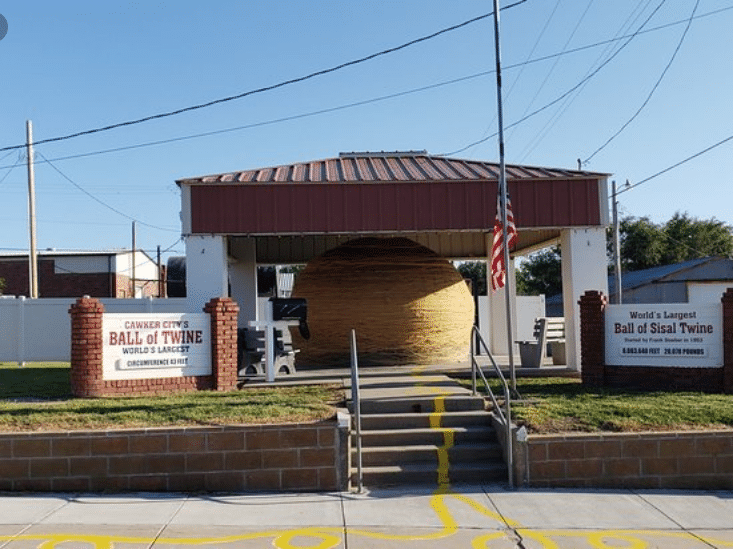
Cawker City, Kansas: Home of the World’s Largest Ball of Twine
by Nabewise
The granddaddy of all roadside attractions, and the town it calls home, provide the backdrop for an unexpected dose of long forgotten Americana.
In my many travels across these United States, I have come to the conclusion that there are five landmarks every good American traveler must visit: Mount Rushmore, the Saint Louis Arch, Niagara Falls, the Grand Canyon and the World's Largest Ball of Twine. Nothing captures the essence of “America” in one spot more succinctly than these locations.
Yes, I know, one of these things is not like the other. But the one common thread each of these places share is that when their names are mentioned, you recognize them instantly as American icons. The Worlds Largest Ball of Twine may not be as forthright in every American's mind as the others, but each and every one of us has heard of it-usually at the butt end of a joke about boring Midwest lifestyles. But for serious road trippers, this is the granddaddy of all roadside attractions, the one that spawned several dozen “world's-largest-ball-of” knockoffs. And, if nothing else, it begs the question: “Why would anyone make a ball of twine to begin with?”
Ask that question of a Midwest farmer and you'll likely get a bemused grin in return, “Yer a city slicker ain't ya?”
Before the advent of baling wire, hay bales were bound with twine. Farmers couldn't just leave the scrap pieces lying on the ground or it would get caught in their machinery. Most simply burned or reused their extra twine, but Frank Stoeber of Cawker City, Kansas started saving his back in 1953. By 1961 the twine ball he'd created could no longer fit inside his barn so he rolled it out and donated it to the town. Pulling a stunt like that in New York City would likely have gotten Stoeber arrested and the twine hawked on the street. In Cawker City, it turned him into a local legend and made the ball a staple of roadside attractions.
There are actually three cities claiming to be in possession of the world's largest ball of twine. The other two are in Darwin, Minnesota and Branson, Missouri. The Branson ball is the one that's actually in Mr. Guinness's record book, but as far as this writer is concerned, it's a complete copout. “Some Guy”-his name doesn't even bear mentioning-heard about the two other twine balls in the late 1980's and decided to attract some attention of his own. So he paid “Some Other Guy” to help him spend four years winding a ball from donated pieces of nylon twine, using a system of pulleys to wrap it. After the record books gave him credit, he sold his creation to Ripley's Believe it or Not, which houses it in its Branson museum… which, of course, means you have to pay to see it. To me-as well as many other purists-that just plain wrong. The Cawker City and Darwin balls originated out of the grass roots of America, beginning simply as a means of efficiency, and becoming famous only years later. That is the American way. The ball in Branson is nothing more than the American money machine in twine form.
My wife Lauren and I, took our cue from the book ECCENTRIC AMERICA by Jan Friedman and approached Cawker City in north-central Kansas one Saturday afternoon in March, not knowing quite what to expect. Would it be touristy with crowds of people swarming around for pictures? That was hard to imagine by the middle-of-nowhere look of the surrounding area. Did the locals get a kick out of the city folk coming in to gawk at their signature landmark? Or did they just shake their heads in disbelief?
Arriving in Cawker City around noon, we drove down the utterly deserted Main Street, past several darkened non-descript buildings, the kinds favored by insurance companies and realtors. Looking back and forth we didn't see the ball of twine… or any people for that matter. Even the lone gas station in town appeared to be closed. Before we knew it we were already on our way out of town. Cawker “City” certainly seemed to be a relative term. We turned around and drove slower this time, but still no twine. From what I've heard, we weren't the first people to have missed it on the first couple passes.
Finally, on our third attempt, and without any fanfare, there it was. All 17,000 pounds and 7 million feet of it. Unlike its counterparts in Darwin, which rests behind a barrier of glass, and the one in Branson, which is just too contemptible to mention again, Cawker City's famous ball sits in an open-air pavilion on the side of Main Street, Route 24, allowing anyone to walk right up and touch it. There are pros and cons to that kind of openness. While it makes the roadside attraction much more inviting and hospitable to travelers, there are people in this world who simply have no respect for anything. Years and years of parents letting their kids climb on top of the ball for pictures have caused the twine to dimple and fray. A few years back somebody even tried to set the twine on fire, forcing the town to periodically spray it with fire retardant.




